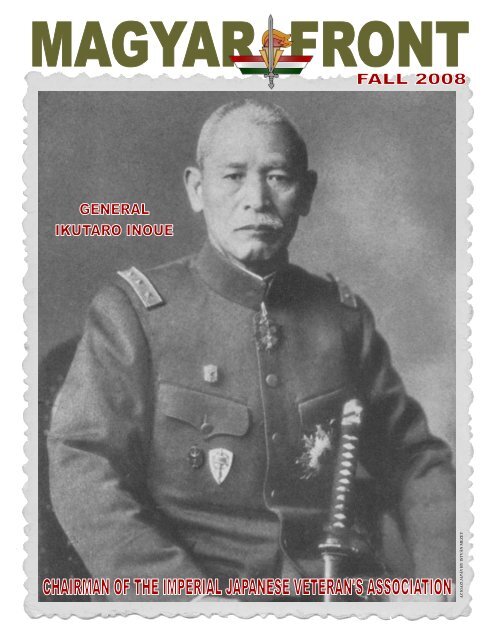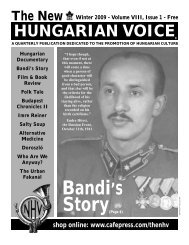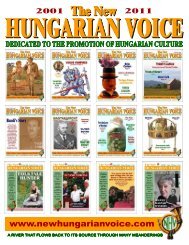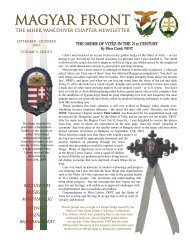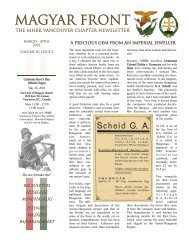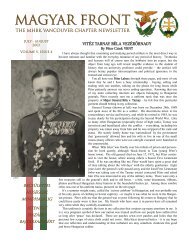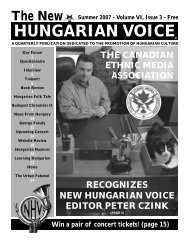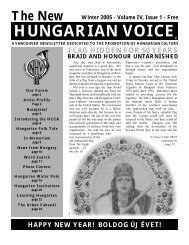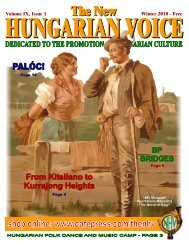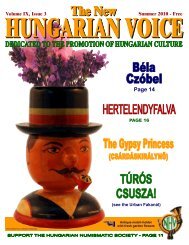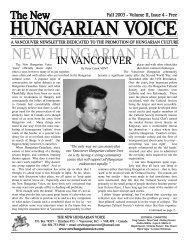volume x, issue 4 - new hungarian voice
volume x, issue 4 - new hungarian voice
volume x, issue 4 - new hungarian voice
You also want an ePaper? Increase the reach of your titles
YUMPU automatically turns print PDFs into web optimized ePapers that Google loves.
AZ IGAZI JAPÁN BY ISTVÁN MEZEY
A note from the Editor2MAGYAR FRONTVOLUME X, ISSUE 4FALL 2008Published quarterly byPeter Czink VRNT, EditorPhotography byLorraine Weideman(unless otherwise noted)The New Front:(International Hungarian MilitaryHistory Preservation Society)Peter Czink VRNTPresidentLorraine WeidemanVice-President, WebmasterPeter v. LaborcVice-President, HungaryJohn KeirVice-President, United KingdomGergely Pál SallayHistorical Consultant,CorrespondentPO Box 74527 Kitsilano POVancouver, British ColumbiaV6K 4P4 Canada 604 733-9948czink@shaw.cawww.<strong>new</strong>front.com©2008 All rights reservedMembership in theInternational Hungarian Military HistoryPreservation Society is $40.00 annually,and includes both the Magyar Front andthe New Hungarian Voice periodicals.The original Magyar Front was theweekly <strong>new</strong>spaper of the Front-LineFighter’s Association, and waspublished from the early 1930s untilthe end of the Second World War.I am very excited about the “<strong>new</strong> front” – the InternationalHungarian Military History Preservation Society. We havealready received many inquires, and I can feel that sheddingour highly-charged political affiliation, and embarking in a <strong>new</strong>direction was a very sound decision.We are currently working on administrative details, and will soon be updating ourwebsite. You will “meet” Péter v. Laborc in this <strong>issue</strong>, and future <strong>issue</strong>s will introduceother dedicated members to you. It is my sincere hope that our organization will be acentral point for hobbyists and historians to share their knowledge and ideas.For years, I have encountered misinformation about Hungary’s Company Officer’sBadge, and finally, we have, courtesy of Gergely Sallay, a definitive article on thesubject. Work like this will set records straight and be a great benefit to the study ofmilitary history.The main theme this time is remembrance, however, and I think it’s a good way tostart out on our <strong>new</strong> journey. For most people, remembrance isn’t a full-time job – likeit is for many of us. Professional historians and amateur collectors share a significantcommon bond – an interest in preserving a part of the past that is often overlooked.I sincerely hope that our New Front will facilitate a <strong>new</strong> kind of memorial, and whetherwe are history buffs or advanced experts, may it inspire us to explore our interest moredeeply and with an open mind, and to generously share it with abroader audience.Finally, near the end of this <strong>issue</strong> is a brief article on militaryre-enacting. It’s a relatively <strong>new</strong> hobby, and whether or not youhave the time or inclination to set up a tent or dig a trench, itsexistence is significant. I constantly hear from my elders that“young people don’t care about our military history.” I think thatmany of them do care – a lot.I hope you all enjoy our publication, and please keep in mindthat I welcome any thoughts, comments or criticisms. Welcome tothe New Front!P.Cz.Our Cover:A PORTRAIT OF JAPANESE GENERAL IKUTARO INOUEIn a previous <strong>issue</strong> of the Magyar Front (Volume X Issue 2, pp. 10-13), I gave anaccount of some aspects of the relations between the Hungarian and Japanese frontlinefighters in the late 1930s and early 1940s. In the article, I touched upon Dr. IstvánMezey’s trip to Japan in 1938-1939. In the course of his trip, Dr. Mezey, founder andlater chairman of the Magyar-Nippon Társaság (Hungarian-Japanese Society), honoraryprofessor of Senshu University, Tokyo, contacted the leaders of the Imperial JapaneseVeterans’ Association (Nippon Teikoku Zaigo Gunjinkai) on behalf of the HungarianFrontline Fighters’ Association and presented the association’s Badge of Honour toGeneral Ikutaro Inoue, Chairman of the association, on January 5 th , 1939.After the article was published, fellow researcher Mr. Péter Wintermantel verykindly drew my attention to a portrait of General Inoue (pictured on our cover)published in Az igazi Japán (The Real Japan) by István Mezey (<strong>issue</strong>d by the Magyar-Nippon Társaság in 1939). In the picture, General Inoue is seen wearing the Badge ofHonour of the Hungarian Frontline Fighters’ Association on the right breast pocket ofhis uniform beside that of the Japanese Association. In this most interesting portrait, thebreast star of the 1st Class of the Order of the Rising Sun and the 3rd Class insignia ofthe Order of the Golden Kite can also be seen on his left breast and around his neck.Above the right breast pocket of his tunic, another version of the badge of the JapaneseVeterans’ Association can be seen. The image is much more detailed than the onepublished in Issue 2 of the Magyar Front earlier this year, and it is a remarkable and rarevisual source of the international relationships of the Hungarian Frontline Fighters’Association.Gergely Pál Sallay
Péter v. Laborc - “New Front” Hungarian Vice-PresidentPéter v. Laborc, pictured here with his daughter Zsófia, is the <strong>new</strong> Vice-President (Hungary) of the InternationalHungarian Military History Preservation Society. Our association is known as the Nemzetközi Társulat a MagyarHadtörténelmi Hagyományokért in Hungarian, and Péter is ready to address any inquiries written in Hungarian, and to act asan official representative of the “New Front” in Hungary.Already well-known to many of our members, his is a household name in Hungarian militaria and military history circles.Born in 1955, he was raised and schooled in Tata, and spent the early part of his life working for the Hungarian PostalService. He has been interested in history and historical artifacts since childhood, and by high-school he was already a seriouscollector of militaria – specifically uniforms and equipment. He was particularly drawn to the Horthy regency period, andsoon became an expert – helped along by his affection for those romantic inter-war years when Hungary seemed to be at itszenith. His grandfather was a lieutenant-colonel during the First World War, and his father served as a captain of theengineers in World War II.Péter has always gone out of his way to share his collection and knowledge, and has been involved in countless displaysand historical exhibitions over the years. His uniforms and equipment, as well as many of his thousands of Hungarianpostcards and period photographs have appeared in many books and publications. He believes “that it’s of the utmostimportance to understand our forefathers’ history – no matter what part of the world we live in. Through that understandingwe will become better acquainted with the history of our homeland.” Anyone who has been touched by his enthusiasm willattest to his sincerity and reliability – he is always ready to help a fellow enthusiast.In 2003, Péter was awarded membership in the Order of Vitéz. Interestingly, he was initially invested with the peace-timepost-nominal letters VRNT for his own merit and service, and later, because of his father’s military record, he was awardedthe hereditary title of vitéz. His decorations and medals include the Gold Cross of Merit of the Order of Vitéz, the MHBKCross of Merit, the MHBK Gold and Silver Medals of Merit, the MHBK Vancouver Chapter 1956-2006 CommemorativeMedal, and the Austrian Veterans’ Association Silver Medal of Merit.Currently, a number of very historically significant pieces from his collection are on display at the Komárom 1938-1945retrospective exhibition at the György Klapka Museum, Kelemen László Street 22, Komárom, Hungary. The exhbit will beopen until March 31st, 2009.Péter can be contacted (in Hungarian) at laborcemail@freemail.hu.3
CZINK COLLECTIONCZINK COLLECTIONThe Company Officer’s BadgeAlthough it was one of the most common Hungarian military badges ofthe interwar period and the Second World War, militaria collectors and evenhistorians and museum curators seem to know very little about theCsapattiszti jelvény, or Company Officer’s Badge.This most characteristic badge was introduced in 1920 for the RoyalHungarian National Army (called the Royal Hungarian Defence Forces from1922) to distinguish commissioned officers of the various arms of service(infantry, cavalry, artillery, armoured troops and engineers), from officersthat served in motorised and horse-drawn train units and the supply troops.From 1939, officers of the Royal Hungarian River Forces were also authorisedto wear the badge. The highest position, the holder of which was stillentitled to display the badge on his uniform, was that of a regimentalcommander. Those officers who were transferred to a higher command orauthority, were not permitted the wear the badge anymore.The Company Officer’s Badge was the first officially instituted badge ofthe <strong>new</strong> independent Hungarian army after the First World War and it wasused until the end of the Second World War. The design of the badge wasentirely <strong>new</strong> and it reflected the independence of the Hungarian nationalarmy through the portrayal of the most important national symbols: theHungarian Holy Crown, the double cross and the triple mounds (theelements of the national coat-of-arms). Other components like the nakedsword and the wreath of oak and laurel leaves were meant to reflect themilitary character of the badge. The sword, held by a hand, representedleadership and was an appropriate reference to the service of companyofficers. It is noteworthy that the badge was designed by Major KamilAggházy, founder of the Royal Hungarian Military History Museum,Commissary Major Ferenc Péter and Second Lieutenant László Gy. Pethely,a renowned industrial designer of the period who also created the insignia ofthe Order of Vitéz. Major Aggházy’s participation in the project suggeststhat the Military History Museum, which was established in late 1918, tookan active part in the creation of the system of the <strong>new</strong> Hungarian nationalmilitary symbols.The Company Officer’s Badge had to be worn in the middle of the rightbreast pocket of the officer’s tunic (or on the greatcoat, pelisse or atilla coatin the same position). From 1933, it was compulsory to wear it with theparade dress, the mess dress and the service dress, but it was not allowed tobe worn in marching order. Officers often attached a cloth backing in armof-servicecolour to the badge. In photographs taken at officer’sinauguration ceremonies, military academy graduates can already be seenwearing their Company Officer’s Badges.The badge was struck of copper alloy, gilt and enamelled. There wereseveral manufacturers that produced the Company Officer’s Badge, sopieces may vary in material, finish and measurements. There are exampleswith maker’s marks being stamped into their reverse or into the fasteningclasps on their backs, but the badges typically are not marked. The badgeshown in the enlarged picture at right measures 53.5mm by 45mm.Gergely Pál SallayAbove: Youthful First Lieutenant (főhadnagy) Viktor Orzechovsky,recently awarded the Company Officer’s Badge, poses in his Model1926 társasági díszatilla dress uniform, sometime during the late 1920s.Below: An unidentified captain (százados) wearing theModel 1939 officer’s service tunic sometime in the early 1940s.The Reclamation of Transylvania Commemorative Medal,the officer’s Border Rifles branch-of-service insignia, and theCompany Officer’s Badge decorate his uniform.4
Below: Enlarged photograph ofa Company Officer’s Badge, from theHungarian Military History Museum.This example has particularly light coloured,translucent enamelling on the oak andlaurel-leaf wreath.Bottom: four different manufacturer’sVariations shown actual size (note the twobadges with branch-of-service coloured woolbacking - red for artillery and green for infantry).Right: Drawings of the badge - actual sizeand enlarged, from official regulations.PÉTER SZIKITS PHOTOCZINKCOLLECTION5
FRONTHARCOS!Pictured at left(shown half-size) are two<strong>issue</strong>s of a publication thatwas entirely unknown tome: Frontharcos –the pre-Magyar Frontperiodical of the HungarianVeterans’ Association.Before becoming anindependent nationalorganization, the veterans’association was a part ofthe conservative andnationalistic M.O.V.E.(Magyar OrszágosVéderő Egylet).The Veteran’sMemorial InsigniaOne of the articles in the latter <strong>issue</strong>is about the “Veteran’s MemorialInsignia” (Kegyeleti frontharcosjelvény).It announced that the leadershipof the association has instituteda <strong>new</strong> memorial insignia, or plaque forthe tombstones of frontline fighters.Similar in design to the standardmembership badge but fifteen timeslarger, it would be produced inweather-resistant metal.Family members of deceasedcombatants could obtain the memorialplaque, free of charge, by providingdocumentation of their frontlineservice. For those soldiers who werenot awarded the First World Warcombatants’ Karl Troops’ Cross, orKárolycsapatkereszt, but who qualifiedfor it, the plaque could be purchased bytheir descendants provided that theyhad the appropriate frontline servicedocuments.CZINK COLLECTIONThe April 1930 <strong>issue</strong>(orange cover) was theirfirst one, and the examplewith the green cover is fromJune of 1931. The veterans’association continued toexist within M.O.V.E. untilFebruary 17 th , 1932.6
Cast metal shieldmeasuring 20.9cm x 32.7cm(shown here smallerthan actual size).Three holes for mountingand a curved blank “scroll”near the bottom, most likelymeant for inscription, canclearly be seen.CZINK COLLECTIONAlthough the onlyreference to this insigniaI have encountered isreproduced on theprevious page, thisup-until-now unidentifiedveterans’ association shieldis most probably theVeteran’s Memorial Insignia.7
HungarianThree views of the M1920 officer’s field cap.
RegulationsField cap rosette, general’s eagle feather decoration, and an example of a two-colour branch-of-servicetriangle. The practice of wearing the eagle feather was discontinued in the mid-1930s.
CZINK COLLECTIONCZINK COLLECTIONComrade! Do not forsake me!The fallen soldier, in the National Frontline Fighters’ Association’s poster from 1930 (pictured in the period almanacFrontharcos Eszme Szólgálatában and reproduced at left), commands us not to forsake him. This is certainly one of the mostmoving and poignant war posters that I have encountered, and graphically illustrates the themes of memorial and remembrance- so important that the frontline fighter has broken out of his grave to remind us. As we study history scientifically andobjectively, and if we look more deeply at our collections and related hobbies, we endeavour to do what soldiers like himmight have hoped for. For many of us, every day is Remembrance Day - even though many of the monuments are gone.The postcard picturedat right (shown actual size)is of a Frontline Fighter’smonument in Várpalota,a town in WesternHungary in the countyof Veszprém.The familiar badge canclearly be seen, and is evenmore prominent in thephoto above - a privatesnapshot of a group ofpeople visiting the samememorial.The little photo,considerably enlargedhere, has no caption ordate, but it looks like twomothers and their children.One can’t help butwonder if one or bothof their husbands werefrontline fighters, beingremembered that day.Memorials from the past...11
SALLAY PHOTOCZINK COLLECTION...and those of todayThe three classes of theHungarian Ministry of Defence’sHungarian War GravesCustodianship Merit Award,or Magyar Hadisírgondozásért KitüntetőCím (Gold, Silver and Bronze),pictured at left (actual size), continuethe tradition of dramatic andthought-provoking design.They are currently awarded forexemplary service in the maintenanceof war graves, war monuments andmemorials. The awards are <strong>issue</strong>dconsecutively for continuedexceptional service, and aminimum of three years mustpass before a recipient is eligiblefor the next, higher grade.Its design is clearly based on that ofthe old Tűzkereszt (Fire Cross), andon the arms of the cross, the mottoPro Custodia - Tumulorum - Militumis inscribed.The old Frontline Fighters’Association insignia (see detail below)can still be seen on this tombstone inBudapest’s Farkasréti Cemetery.12
SALLAY PHOTOSALLAY PHOTOSALLAY PHOTOThis memorial is in the garden of local government building,in Badacsonytördemic. It’s clearly a Frontline Fighters’ Association monument(see the detail of the insignia at left) that has survived to this day.Below: tombstones in Keszthely, for members of the old veterans’ association - VilmosVértessy (middle), an artillery captain, was killed in action on the Eastern Front, andwas presumably the son of Vilmos Vértessy Sr. (left). The inscription at the bottom ofSándor Vértess’s memorial states that it had been destroyed by Allied bombing in 1944.These remarkable photos were taken earlier this year by Gergely Pál Sallay.SALLAY PHOTO13
14HUNGARIAN HISTORICAL RE-ENACTINGMilitary re-enacting is almost as old as warfare itself. Early men would have undoubtedly been keen on demonstratingtheir martial exploits, and modern veterans can often be found re-living their wartime memories. Once stripped of theirbravado, military tales become history, to be communicated to future generations through education.From ancient Grecian amphitheatres to American Civil War battlefield re-enactments, what once served to glorify Hellenicheroes has become not only a dynamic hobby, but also an exciting way for people to immerse themselves in living history.John Hajnal’s “profound respect and admiration for those who have served their country, whatever country that may be,”prompted him to become involved in re-enacting, and considering his heritage, his country of choice was Hungary. Beingborn and raised in the United States and speaking little Hungarian, he quickly realized the obscurity of his interest – the onlyHungarian military re-enactment groups were in Hungary, and the hobby still in its infancy at that. He persevered, and overthe next few years, he put together a complete WW II Hungarian infantryman’s kit, and has started the first Hungarianmilitary re-enactment group in North America – a tribute to the 6 th Royal Hungarian Infantry Regiment.“It is our goal to expand our unit to help to educate people about Hungarian participation in World War II – we would liketo attend more events, and we’re looking for <strong>new</strong> members,” says Hajnal. Re-enacting is growing in popularity, and is anexciting way for people to immerse themselves in whatever period of history that fascinates them most. Hajnal sees it as selfeducationthat encourages historical preservation. “I enjoy re-enacting because it gives me a better understanding of what thesoldiers went through. Once, while at a weekend re-enactment in -5° weather, I woke-up and realized that I had no feeling inmy legs – I could imagine how much worse the soldiers must have had it, yet they carried on.”John Hajnal is excited about the future of re-enacting: “I have a love for Hungarian military history. This hobby is popularin Hungary, but for me to start a unit over here will be a long process. My plans are to reach out to the re-enacting communityto get more people interested, and to spread knowledge about Hungary’s part in World War II.”As a society, it has become much easier to choose pastimes that are dictated to us by the media and its advertisers.Especially for young people, military history isn’t in the top ten list of popular interests. Re-enacting is a very clever anddynamic way to promote interest in military history, and to educate the people around us.John Hajnal’s <strong>new</strong> website is a work in progress - have a look: http://web.mac.com/magyarsoldat/Site/Home.htmlYou can spend a lot of time looking through the various other re-enactment sites on the internet - here are just a few:Hungarian Huszárs - www.magyarhuszar.hu/site/index.html WW I Austro-Hungarians - http://kuk.armiam.com/WW II Soldiers - www.kiralyihagyomanyorzok.eu/index_1.html Post WW II Re-Enactors - www.veteranmilitari.hu/
Our ShopOur brand <strong>new</strong> International Hungarian Military History Preservation Society “NewFront” insignia (shown half size). Exquisitely hand-embroidered badge worked in goldand silver bullion on red, white and green velvet. Measuring 6.5cm x 10cm, each badgehas three clutch-back pins on the reverse for wear as a blazer crest.$12.50 (plus postage)Full-size replica of the Hungarian Officer’s Bronze Medalwith the Holy Crown, or “Signum Laudis” on War Ribbon.This is a good quality reproduction of a medal that is gettingquite scarce - an excellent and inexpensive replacement forveterans medal groups or for display.One-piece decoration on proper tri-fold ribbon.$10.00Full-colour, full-size (15cm x 17cm)reproductions of the World War II HungarianMilitary vehicle insignia.Printed on square white peel-and-stick paper:$2.50Our BookshelfRise Up! The 1956 Hungarian Revolution - A People’s Sacrifice $10.00Our 64 page booklet published for the 2006, 50th anniversary of the 1956 Revolution.Filled with exclusive articles, photos and illustrations, black and white with colour soft-cover.Memoirs of a Hungary Soldier (see Magyar Front July – August 2007 Volume 1X Issue 4 for more information)www.lulu.com - type “Gyokeri” into the search box and you’ll find it. $25.00 (soft cover, 105 pages)The Royal Hungarian Armed Forces 1919 – 1945: 166 pages, $30.00 • The Fallen Generals: 146 pages, $25.00La Regia Marina 1919 - 1945: 66 pages, $22.50 • The Armed Forces of Latvia 1918 - 1940: 151 pages, $30.00The Luftwaffe 1935 - 1945: 144 pages, $30.00 • Between Kaiser and Führer: 131 pages, $30.00Books by Andris Kursietis can be ordered through his website: www.arkmusiccorp.comClick on Publishing Company in the About Us section. All books are soft cover, perfect-bound.Visit the “New Front” online shop!www.cafepress.com/theNewFrontOur <strong>new</strong> online shop is hosted by CafePress, an online printing company that provides very high quality merchandise,prompt shipping, safe online payment options and excellent customer service. Check in often for our latest products!15
www.hm-him.hu


